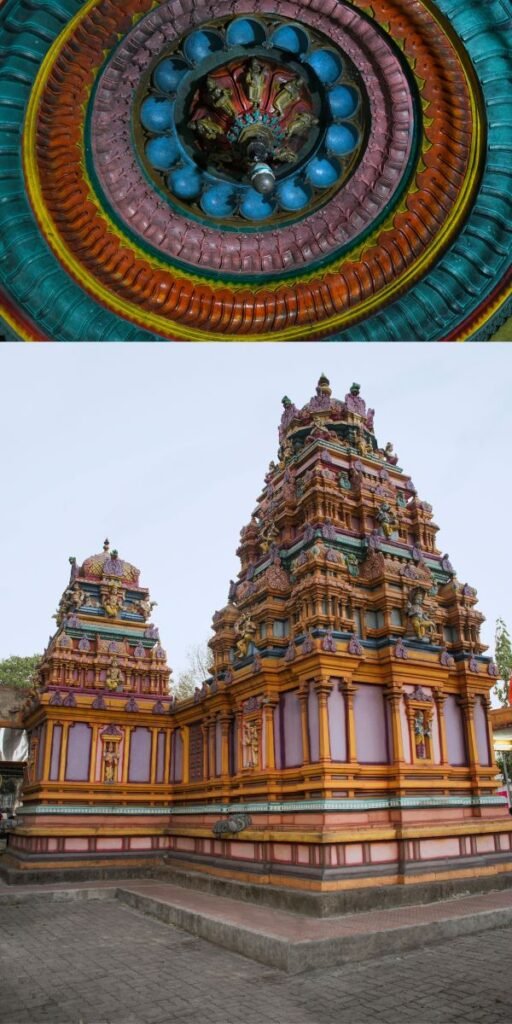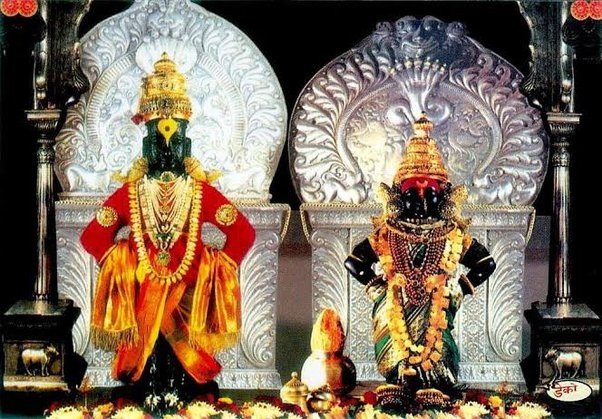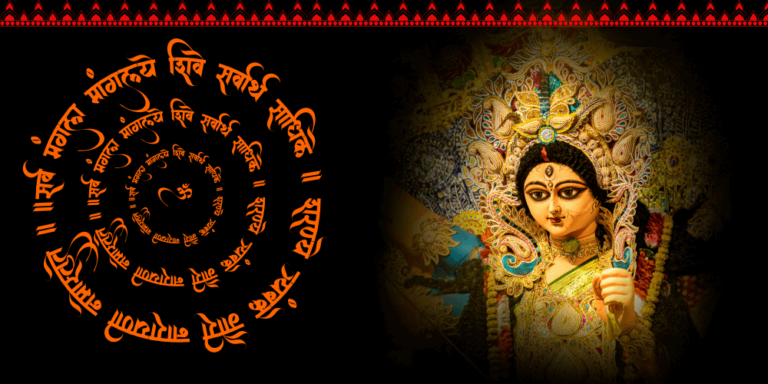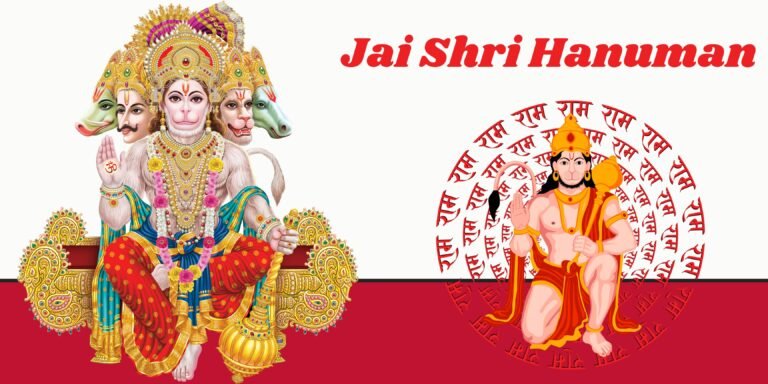Table of Contents
- 0.1 Discover the Divine Presence of God Vitthal: The Eternal Guardian of Devotion
- 0.2 Respect for Vitthal and Rukhumai
- 0.3 Yeii ho Vitthale maajhe Mauli ye ॥
- 0.4 Pandharpuratil Vitthal Dev Rakhumai chi Aarti
- 0.5 Vitthal Aarti meaning in english:
- 0.6 Watch Yei Oh Vitthale | 🕉️येई ओ विठ्ठले माझे माऊली ये! | Vitthal Aarti in Marathi | विठ्ठल आरती
- 1 Frequently Asked Questions
- 1.1 Who is Lord Vitthal?
- 1.2 What is the significance of the Vithoba Temple in Pandharpur?
- 1.3 Why is Lord Vitthal also called Vithoba or Panduranga?
- 1.4 What is the story behind Lord Vitthal’s standing posture with hands on his waist?
- 1.5 Who was Pundalik, and what is his connection to Lord Vitthal?
- 1.6 What is the Ashadhi Ekadashi pilgrimage?
- 1.7 Who are the Warkaris, and what is the Wari tradition?
- 1.8 What role do saints like Sant Tukaram and Sant Dnyaneshwar play in Vitthal devotion?
- 1.9 Why is Lord Vitthal worship seen as a symbol of equality and devotion beyond caste and class?
- 1.10 What is the spiritual message of Lord Vitthal’s legacy?
Discover the Divine Presence of God Vitthal: The Eternal Guardian of Devotion
In the heart of Maharashtra lies the spiritual haven of Pandharpur, home to the revered Vithoba Temple, where countless devotees gather to seek the blessings of God Vitthal, also known as God Vithoba. This sacred place is a testament to unwavering devotion, where Lord Vitthal and his consort, Rakhumai (or Rukmini), have been worshipped for centuries.
The Legend of God Vitthal and Rakhumai

The story of Lord Vitthal is deeply rooted in the Bhakti movement, where he is venerated as an incarnation of Lord Krishna. The tale begins with a young devotee named Pundalik, whose selfless service to his parents touched the heart of the divine. God Vithoba, moved by Pundalik’s devotion, decided to visit him in his home. But Pundalik, so engrossed in serving his parents, placed a brick for the deity to stand on while he completed his duties. This act symbolized the humility and devotion that Lord Vitthal embodies, and thus, the image of Vitthal standing on a brick became iconic.
The Vitthal Rukmini Murti inside the Vithoba Temple is not just a symbol of divine presence but also of the eternal bond between Vitthal and Rakhumai. The Vitthal Murti, along with the Rakhumai statue, represents the deep spiritual connection that binds the devotees to their divine protector.
The Sacred Vithoba Temple and Its Rich Heritage
The Vithoba Temple in Pandharpur is a pilgrimage site that attracts millions of devotees each year. The Shree Vitthal Heritage is a testament to the temple’s long-standing significance, steeped in traditions that have been passed down through generations. The temple’s architecture is a blend of ancient and medieval styles, with intricate carvings that depict the life and miracles of Lord Vitthal.
Devotees from all walks of life come to witness the Live Vitthal Darshan, where the serene image of Lord Vithoba fills their hearts with peace and devotion. Many also opt for the Vitthal Rukmini Live Darshan option available online, where they can experience the divine presence of Lord Vitthal and Rakhumai from the comfort of their homes.
Accommodations for Devotees: Shri Vitthal Rukmini Bhakta Niwas
For those who make the pilgrimage to Pandharpur, the Shri Vitthal Rukmini Bhakta Niwas offers a serene place to stay. Located close to the Vithoba Temple, it provides modern amenities while maintaining a spiritual atmosphere. The Vitthal Rukmini Bhakta Niwas is an embodiment of the hospitality that God Vitthal and Rakhumai are known for.
The Divine Experience: Vitthal Rukmini Online Darshan Pass
In today’s digital age, devotees who cannot travel to Pandharpur can still seek blessings through the Vitthal Rukmini Online Darshan Pass. This service allows devotees to participate in the Live Vitthal Darshan and witness the Vitthal Rukmini Murti through a virtual experience. The Vitthal Rukmini Live Darshan ensures that distance is no barrier to devotion.

Revering the Vitthal Rakhumai Duo
The Vitthal Rakhumai duo is at the heart of Maharashtrian culture and spirituality. The Vitthal Rukmini Murti inside the Vithoba Temple serves as a reminder of their enduring love and the divine grace they bestow upon their devotees. Each visit to the temple, each glimpse of the Lord Vitthal Photo, reaffirms the unbreakable bond between the divine and the devotee.
Respect for Vitthal and Rukhumai
At the heart of Maharashtrian culture and spirituality lies the divine pair of Vitthal and Rukhumai. The idols of Vitthal and Rukmini in the Vitthoba temple symbolize their eternal love and the grace they bestow upon their devotees. Every visit to the temple, and every glimpse of a photo of Lord Vitthal, reaffirms the unbreakable bond between the divine and the devotee.
Yeii ho Vitthale maajhe Mauli ye ॥
Yeii ho Vitthale maajhe Mauli ye.
Nidhalavari kar thevunii vaat mi paahe. ॥ Dhru० ॥
Yeii ho Vitthale maajhe Mauli ye.
Aaliya geliya haatin dhaadi nirop,
Pandharpurin aahe maazha Maaybaap. ॥ Yeii ho ॥ 1 ॥
Yeii ho Vitthale maajhe Mauli ye.
Pivla Peetambar kaisa gaganin jhalakla,
Garudavari baisoni maazha Kaivari aala. ॥ Yeii ho ॥ 2 ॥
Yeii ho Vitthale maajhe Mauli ye.
Vithobache raajya aamha nitya Deepavali,
Vishnudaas Naamaa jeeven bhaaven owaali. ॥ Yeii ho ॥ 3 ॥
Pandharpuratil Vitthal Dev Rakhumai chi Aarti
Yuge atthavees vitevari ubha,
Vaamangi Rakhumai dise divya shobha.
Pundalikache bheti Parabrahma aale ga,
Charani vaahe Bhima uddhaari jaga. ॥1॥
Jai Dev Jai Dev Jai Panduranga,
Rakhumaai-vallabha, Raichya vallabha, paave jivalaga. ॥Dhr.॥
Tulsi mala gala kar thevuni kati,
Kaanshe peetambar kasturi lallati,
Dev survar nitya yeti bheti,
Garud Hanumant pudhe ubhe rahati.
Jai Dev. Jai Dev. ।।2।।
Dhanya Venunaad Anukshetrapala.
Suvarnaachi Kamale Vanmala Gala.
Rai Rakhumabai Raniya Sakala.
Owaliti Raja Vithoba Sawala.
Jai Dev. ।।3।।
Ovaalu aartya Vithoba Saawala ।।
Jai Dev ।।3।।
Ovāḷū āratyā kurvaḍyā yetī,
Chandrabhāge mājī soḍuniyā detī.
Dinḍyā patākā Vaishṇav nāchatī,
Pandharīchā mahimā varṇāvā kitī.
Jai Dev. ।।4।।
Aashaadhi Kaartiki bhaktjan yeti,
Chandrabhage madhye snaan je kariti.
Darshan hela maatren taya hoy mukti,
Keshavaasi Naamdev bhaave omvaliti.
Jai Dev Jai Dev. ॥5॥
Vitthal Aarti meaning in english:
युगे अठ्ठावीस विटेवरी उभा ।
वामांगी रखुमाई दिसे दिव्य शोभा ।
पुंडलिकाचे भेटी परब्रह्म आले गा ।
चरणी वाहे भीमा उद्धरी जगा ।। १ ।।
Vitthal of Pandharpur stands on a brick, steadfast since twenty-eight yugas.
By His left side stands Rukhumai, and with their divine radiance, Pandharpur is illuminated.
The Supreme Being, Vitthal, drawn by Pundalik’s devotion, has made His abode here in Pandhari.
At His sacred feet flows the Bhima river, ever ready to uplift and redeem His devotees. || 1 ||
जय देव जय देव जय पांडुरंगा ।
रखुमाईवल्लभा, राईच्या वल्लभा पावे जिवलगा ।।
जय देव जय देव ।। धृ० ।।
O Lord Panduranga, may your glory be praised!
O beloved husband of Rakhumai and Rahi, my dearest companion of life,
Please keep your gracious gaze upon me — this is my humble request at your feet!
(The wives of the gods are symbols of their divine energy (Shakti). They manifest in two forms — as saviors (Tarak) and as destroyers (Marak). Vitthal, who is the god of sustenance among the three aspects of creation, preservation, and dissolution, has two powers associated with creation and preservation.)
।। धृपद ।।
तुळसीमाळा गळा कर ठेवुनी कटी ।
कासे पीतांबर कस्तुरी लल्लाटी ।
देव सुरवर नित्य येती भेटी ।
गरुड हनुमंत पुढे उभे रहाती ।। २ ।।
Vitthala has adorned a tulsi (holy basil) garland around His neck and has both hands placed on His waist. He wears a yellow pitambar (silken cloth) around His waist, and a tilak of musk (kasturi) adorns His forehead. Great deities visit daily to behold this divine form of the Supreme Being in the form of Vitthala. Garuda and Hanuman always stand before Vitthala with folded hands in reverence.
धन्य वेणूनाद अनुक्षेत्रपाळा ।
सुवर्णाची कमळे वनमाळा गळा ।
राई रखुमाबाई राणीया सकळा ।
ओवाळिती राजा विठोबा सावळा ।। ३ ।।
While performing the aarti, devotees dedicate it at the feet of Lord Panduranga. They joyfully bring kurvandya — small leaf bowls decorated with little lamps. After offering the aarti, these are immersed in the sacred waters of the Chandrabhaga River.
The Vaishnavas, carrying dindis (pilgrim processions), arrive and dance, lost in divine ecstasy, forgetting their physical selves amid the thunder of flags. Describing the unique glory of Pandharpur is impossible—it is beyond words.
।। ४ ।।
ओवाळू आरत्या कुर्वंड्या येती ।
चंद्रभागेमाजी सोडुनिया देती ।
दिंड्या पताका वैष्णव नाचती ।
पंढरीचा महिमा वर्णावा किती ।। ४ ।।
Devotees bring lit earthen lamps to offer for the Aarti of Pandurang. After performing the Aarti, they immerse the lamps in the Chandrabhaga river. The processions are underway, with Vaishnavite devotees holding flags, dancing with complete abandon, forgetting their physical selves. How much can one describe the glory of Pandharpur? It is impossible to capture it in words! ॥ 4 ॥
आषाढी कार्तिकी भक्तजन येती ।
चंद्रभागेमध्ये स्नान जे करिती ।
दर्शनहेळामात्रे तया होय मुक्ति ।
केशवासी नामदेव भावे ओवाळिती ।। ५ ।।
(O Panduranga,) Every year, on Ashadhi and Kartiki Ekadashi, millions of your devotees come to Pandharpur, take a holy bath in the Chandrabhaga with devotion, have your darshan, and through your grace, they attain liberation. (How immense is the glory of your grace!)
O Keshava, Namdev is offering the aarti with devotion at your feet. (May your grace always be upon them, this is the prayer at your feet!) ॥ 5 ॥
Vitthal Aarti meaning in english
Watch Yei Oh Vitthale | 🕉️येई ओ विठ्ठले माझे माऊली ये! | Vitthal Aarti in Marathi | विठ्ठल आरती
Frequently Asked Questions
-
Who is Lord Vitthal?
Lord Vitthal, also known as Vithoba or Panduranga, is a form of Lord Krishna or Vishnu worshipped mainly in Maharashtra and parts of Karnataka.
-
What is the significance of the Vithoba Temple in Pandharpur?
The Vithoba Temple in Pandharpur is one of the most important pilgrimage sites in Maharashtra, known as the spiritual home of Lord Vitthal.
-
Why is Lord Vitthal also called Vithoba or Panduranga?
These names come from regional languages and traditions; “Vithoba” is a colloquial form, while “Panduranga” reflects his appearance and grace.
-
What is the story behind Lord Vitthal’s standing posture with hands on his waist?
It is believed Vitthal stands waiting for his devotee Pundalik, symbolizing patience, humility, and devotion.
-
Who was Pundalik, and what is his connection to Lord Vitthal?
Pundalik was a devoted son and a great bhakta; he is credited with bringing Lord Vitthal to Pandharpur through his deep devotion and service to his parents.
-
What is the Ashadhi Ekadashi pilgrimage?
Ashadhi Ekadashi is a major festival where millions of devotees (Warkaris) walk in procession (Wari) to Pandharpur to worship Lord Vitthal.
-
Who are the Warkaris, and what is the Wari tradition?
Warkaris are devotees of Vitthal who follow a simple, spiritual lifestyle and undertake an annual pilgrimage by foot, chanting abhangs (devotional songs).
-
What role do saints like Sant Tukaram and Sant Dnyaneshwar play in Vitthal devotion?
These saints spread the Bhakti movement through their poetry and teachings centered on Lord Vitthal, making him accessible to all.
-
Why is Lord Vitthal worship seen as a symbol of equality and devotion beyond caste and class?
The Vitthal tradition emphasizes inner devotion (bhakti) over rituals, welcoming people from all walks of life.
-
What is the spiritual message of Lord Vitthal’s legacy?
Lord Vitthal’s legacy inspires humility, selfless devotion, social harmony, and the belief that God is always close to a true devotee.





